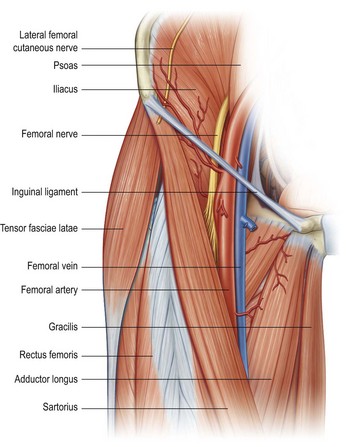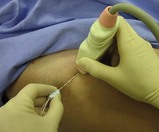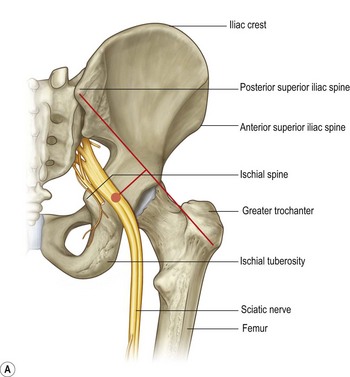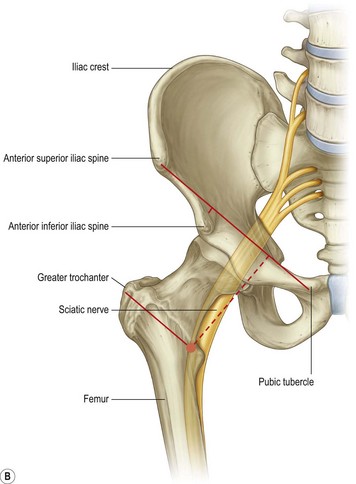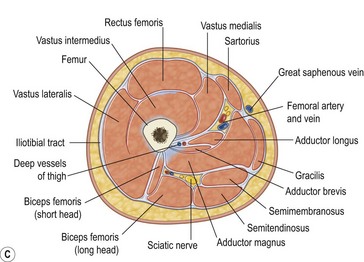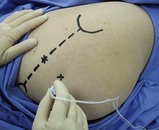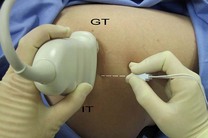CHAPTER 9 Lower limb blocks
Femoral nerve block (3-in-1 block)
Landmark technique
A femoral nerve block is easy to master and has a very high success rate even in relatively inexperienced hands. It has a low risk of complications and has a significant clinical applicability in the ED for post-traumatic pain management of injuries of the femur, anterior thigh and knee. When a femoral nerve block is used in combination with a sciatic nerve block, anaesthesia of almost the entire lower limb distal to the mid-thigh can be achieved. The 3-in-1 block refers to the simultaneous blockade of the anterior branch of the obturator nerve, the lateral femoral cutaneous nerve and the femoral nerve with a single injection. This results from the medial and lateral spread of local anaesthetic injected around the femoral nerve.
The femoral nerve arises from the L2, L3 and L4 nerve roots. The nerve descends between the psoas and the iliacus muscles and passes deep to the inguinal ligament into the thigh (Fig. 9.1). At this point the femoral nerve is positioned immediately lateral to and slightly deeper than the femoral artery. The acronym NAVY is a useful reminder of the arrangement of structures from lateral to medial: Nerve, Artery, and Vein, with Y representing the midline.
A femoral block produces anaesthesia of the entire anterior thigh and most of the femur and knee joint, as well as to the skin on the medial aspect of the leg below the knee joint via the saphenous nerve.
Preparation
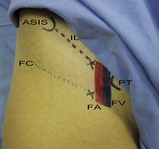
Fig. 9.2 The surface anatomy of the femoral nerve in the proximal thigh. The inguinal ligament (IL) extends from the anterior superior iliac spine (ASIS) to the pubic tubercle (PT), which lies just lateral to the pubic symphysis. The femoral nerve lies at the midpoint of this line just lateral to the femoral artery (FA) and femoral vein (FV). The target point for needle insertion may be at the level of the inguinal ligament (proximal cross) or at the level of the femoral crease (FC).
Technique
Ultrasound technique
The use of ultrasound assistance for the femoral nerve block increases the success rate from 80% with the blind and nerve stimulator techniques to 95%. If ultrasound is used, then it is not necessary to use a nerve stimulator as well.
Preparation
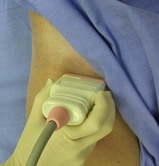
Fig. 9.4 The high-frequency linear probe is placed transversely on the anterior proximal thigh, at the level of either the inguinal ligament or the femoral crease. The initial ultrasound landmark to locate is the pulsatile femoral artery.


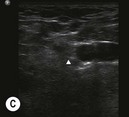
Fig. 9.5 The femoral artery and vein can be clearly seen and distinguished using colour Doppler (A). The femoral vein (FV) lies closest to the midline, the femoral artery (FA) lateral to the vein, and the femoral nerve most lateral (arrows and arrowhead) (B) and (C). The femoral nerve is not always clearly visible before the injection of local anaesthetic, but its position can be precisely inferred from the position of the femoral artery.
Technique
In-plane approach
Out-of-plane approach
The injection process
Lateral femoral cutaneous nerve block
The lateral femoral cutaneous nerve arises from the L2 and L3 nerve roots and provides sensation to the lateral aspect of the thigh. It enters the thigh a variable distance medial to the anterior superior iliac spine (most commonly 10 to 15 mm, but as much as 50 mm) and deep to the inguinal ligament between the layers of the fascia lata and the fascia of the iliacus muscle. This block may be performed on its own or to complement a femoral nerve block.
Preparation
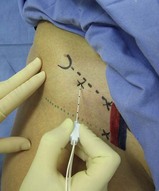
Fig. 9.8 The lateral femoral cutaneous nerve of the thigh may be blocked at a point 20 mm medial and 20 mm inferior to the anterior superior iliac spine. A fan-type of injection to disperse the local anaesthetic increases the chances of block success.
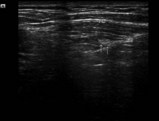
Fig. 9.9 The lateral femoral cutaneous nerve of the thigh can be visualised on ultrasound by positioning the probe immediately medial and inferior to the anterior superior iliac spine. The nerve can be seen between the fascia lata (FL) and the fascia iliaca (FI). It may be blocked using an in-plane or out-of-plane technique. If the nerve cannot be visualised, local anaesthetic can be deposited between the fascial layers about 15 to 20 mm medial to the anterior superior iliac spine.
Technique
Sciatic nerve block
Sciatic blockade (via the posterior, anterior or popliteal approach) has the potential to be one of the most commonly used regional anaesthetic techniques in the ED and can be invaluable for pain management following trauma to the lower limb (Fig. 9.10). This block is relatively easy and is associated with a high success rate when properly performed. It is particularly well suited for injuries to the leg, ankle, and foot. It provides complete anaesthesia of the leg below the knee with the exception of a medial strip of skin which is innervated by the saphenous nerve. When combined with a femoral nerve block or 3-in-1 block, anaesthesia of almost the entire lower limb distal to the mid-thigh is achieved. If spinal immobilisation procedures are required, rather use the anterior or the popliteal approach, which require less movement of the patient and the injured limb.
Fig. 9.10 (A) Posterior view of the course of the sciatic nerve in the pelvis and proximal thigh. The red line indicates the landmarks for the posterior approach to this block. (B) Anterior view of the course of the sciatic nerve in the proximal thigh. The landmarks used for the anterior approach to this block are indicated by the red lines. (C) Cross-sectional anatomy of the proximal thigh.
Posterior approach landmark technique
The traditional posterior approach to sciatic nerve blockade is relatively simple and successful but it has the disadvantage of requiring a significant repositioning of the patient, which might be difficult with an injured limb.
Preparation

Fig. 9.11 With the patient in the lateral decubitus position, mark the midpoint of a line between the posterior aspect of the greater trochanter (GT) and the anterior aspect of the posterior superior iliac spine (PSIS). The target for needle puncture is a point 40 mm (30 to 50 mm) distal and perpendicular to this midpoint.
Technique
Posterior approach ultrasound technique
This block is one of the more difficult of the ultrasound-guided nerve blocks. Although the sciatic nerve is one of the largest peripheral nerves, it is often difficult to visualise because of the depth from the skin and because of the overlying adipose tissue.
Preparation
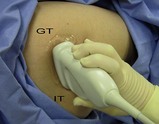
Fig. 9.13 The sciatic nerve is very deep when visualised with ultrasound from the posterior aspect and therefore a curvilinear low-frequency transducer is required. The probe is positioned transversely between the greater trochanter (GT) and the ischial tuberosity (IT) in order to visualise the sciatic nerve. The nerve is often very hard to locate and this block is difficult for novices.

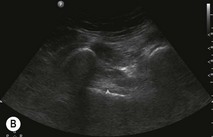
Fig. 9.14 (A)&(B) The sciatic nerve (usually) can be seen as a large hyperechoic oval structure in the medial half of the subgluteal space. The subgluteal space is an echolucent area between two ‘tram-track’ hyperechoic fascial planes running between the ischial tuberosity (IT) and the greater trochanter (GT). The arrows and arrowhead indicate the nerve.
Technique
In-plane approach
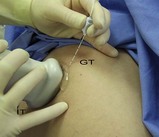
Fig. 9.15 The in-plane approach is most appropriate for this block as the needle has a long path to travel to the nerve. The needle is inserted at the lateral edge of the probe and guided in real time towards the edge of the nerve. The probe is held steadily between the greater trochanter (GT) and the ischial tuberosity (IT).
Out-of-plane approach

